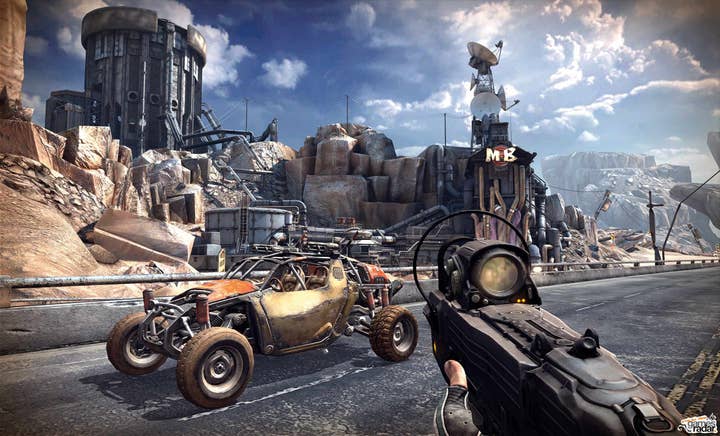Critical Consensus: Rage
id Software's first new IP in many years comes under the reviewers' scrutiny
As a studio which has created not just genre-defining games, but genre-creating ones, id Software have something of a burden of expectation attached to any new release. Recent output, largely in the form of collaborations with external studios, has been mixed, giving rise to Quake: Enemy Territory and a reboot of Wolfenstein, but id's catalogue generally reads like an FPS hall of fame.
This time around we're no longer on terra nova. The farthest corners of the genre have been explored, mapped and retrodden by so many that new discoveries are like hen's teeth. With the advent of Rage, even given the inclusion of fancy new 'megatexture' technology courtesy of id's own Carmack, it seems that reinvention will have to wait.
That's not to say the critical reception has been negative - a healthy console Metacritic score of 81 per cent (PC review code has yet to be distributed), should see retailers giving the shooter/racer/RPG shelf space, but a cluster of low scores in addition to the more positive results may well dilute the game's commercial success.
There's a huge range of critical opinion out there, with scores ranging from 95 to just 58 per cent, but perhaps the most damning assessment comes from Ars Technica's Ben Kuchera, rating the game a 'skip' after a litany of negative insight.
After opening with the brief concession that id's new id Tech 5 engine does produce visually enchanting results, Kuchera finds little to recommend in the title, criticising almost every aspect of the game, from pace to story and mission structure, identifying a lack of depth and sense of place to the game's world and characters.
"I only finished RAGE because I was paid to do so, and the process was a struggle," Kuchera says, towards the end of his piece.
A key factor in this assessment is the feeling that Rage's missions often send the player on something of the run-around, needlessly padding simple tasks by forcing conversations and travel between a number of otherwise inconsequential NPCs.
"It's absurd and pointless," says Kuchera of one quest. "Why can't the first guy just set up the race? What designer sat down and said that the player should have to track down and speak to FOUR PEOPLE to get to the actual action?"
Rage's save system comes under fire, too, as does the crafting system and the issue of plot linearity. Even the passion of the team behind the game is called into question. Kuchera seems to find Rage soulless, designed by committee, saying in closing that: "This is a great tech demo for the engine, and that's all. It's merely competent, but never special."
Though id and Bethesda have used RPG terminology in describing it...It's not much of an open world. It's not very big. It's not very long.
Arthur Gies, Joystiq
Slightly more confident in Rage's ability to wow audiences is Joystiq's Arthur Gies, awarding three stars out of five to a game which he says is "not the return to prominence that id fans have been hoping for."
"It's not an RPG," says Gies, "though id and Bethesda have used RPG terminology in describing it. It's not much of an open world. It's not very big. It's not very long."
Surprisingly, and in contrast to many other critics, Gies finds Rage's technical achievements underwhelming, singling out poor animation, texture pop-in and a lack of dynamic lighting as contributing to a gamer which "occasionally gives everything the appearance of a badly Photoshopped DVD cover."
Racing and side quests are dismissed as being superfluous, adding nothing to a restrictively linear main story which revolves around approaching static NPCs who'll send you off to fetch, activate or kill something when prompted.
The lack of competitive multiplayer strikes Gies as odd, given id's pedigree in that area, and he feels that its omission reflects something of a gap in Rage's key aspect, the moment-to-moment gunplay.

"Tactical considerations are virtually non-existent in the main game," he surmises, "and firefights are often a total grind."
The Telegraph's Ashton Raze doesn't share Gies' concerns about the shooting, praising it as the strongest component in something of a mongrel game before awarding three and a half stars out of five.
Beyond a somewhat hackneyed and familiar opening section comes Rage's first real surprise, says Raze, when the game reveals itself to not quite be the open-world RPG some had proclaimed it to be. Instead of encouraging free exploration, Rage dispenses all main and side quests from one its two main towns, often shuttling the player between the two.








